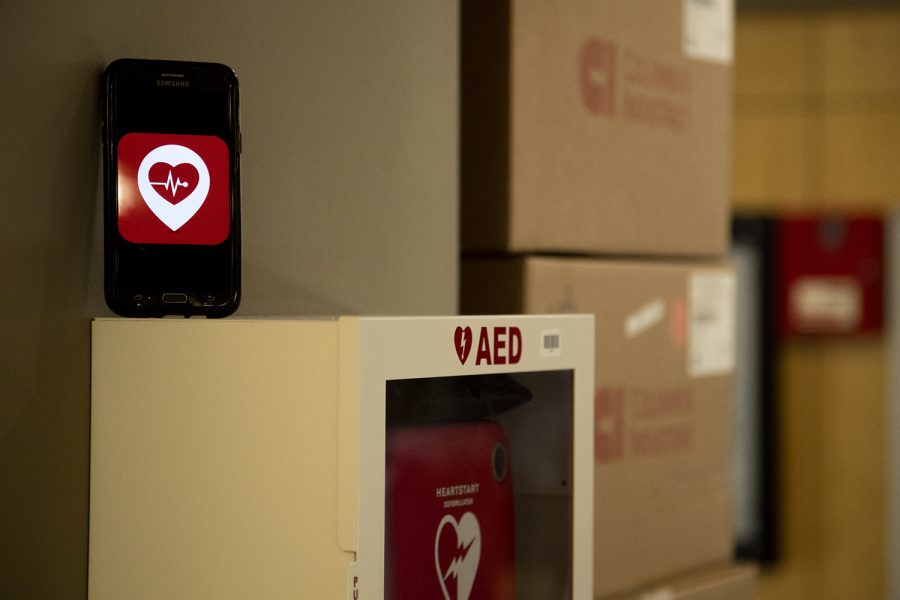Cardiac arrest survival rates increased after PulsePoint app creation
The app, first adopted by Johnson County in February, has significantly increased survival rates in the county.
Photo illustration
October 27, 2022
Nine months after its creation, the PulsePoint app has seen success in helping cardiac emergency situations in Johnson County.
In February, the Johnson County Ambulance Service adopted PulsePoint in collaboration with the Iowa City Rotary Club as part of the latter’s Rotary-Kerber HeartSafe Community Campaign.
PulsePoint comes with two apps, PulsePoint Respond and PulsePoint AED. Respond is the main app, and its purpose is to alert users to when someone nearby is experiencing a Sudden Cardiac Arrest. Meanwhile, PulsePoint AED helps identify where automated external defibrillators (AEDs) are in the county.
The goal of PulsePoint is to have its users respond to the alert by going to the person in need of aid and providing them CPR, Johnson County Ambulance Service Director Fiona Johnson said.
“People will be notified that CPR is needed on their phone, they’ll select ‘guide me,’ and then their phone will guide them to the location of that person that needs CPR, and it will tell them where the closest AED is,” Johnson said.
Ultimately, the app encourages bystander intervention, an important part in increasing a person’s chances of surviving. It’s part of what’s known as the chain of survival, which is made up of five links. The first three are done by bystanders, and the remaining two by first responders.
During a Johnson County Board of Supervisors Joint Entities meeting held Oct. 17, Johnson presented a PowerPoint that stated that PulsePoint-alerted responders were on scene before on-duty fire and emergency medical services personnel arrived by two minutes and 13 seconds.
Elsewhere in the presentation, Johnson shared the survival rates are 32 percent when a bystander witness helps, compared to the national average of 10.1 percent. In addition, bystander intervention rates for CPR are 63.8 percent to 40.2 percent in the nation.
RELATED: App to alert Johnson County citizens of nearby cardiac arrests
For Johnson County Board of Supervisor Jon Green, the app can be especially important for people in the rural parts of the county.
“As someone who lives out in the rural part of the county where an ambulance isn’t going to get to me in ten minutes, knowing that one of my neighbors might be in a position to help me, or vice versa, is just a tremendous thing,” Green said. “It isn’t only the health outcomes, it’s also the social outcome, the social factor of community building. It’s the fact that we’re looking out for one another.”
Plenty of progress has been made, but there’s more to be done, Linda Kerber said, a University of Iowa professor emeritus in history. This includes making more AEDs available and accessible throughout the county.
“We have an ongoing project [where] we’ve already installed a dozen [AEDs], and we have a dozen more on order to install them in weather protective boxes outdoors,” Kerber said.
Another aspect Kerber said is needed is to get more people to either be trained in CPR or have them take a refresher class.
“Many [people have] CPR training, but they need to refresh it, and we have a free training refresher at the Wellness Center,” she said. “And here at the university, all students, graduates and undergraduates, are eligible for free refresher training.”
Kerber also noted it’s important to know that there are new rules for CPR, the most important being that it is hands only now.
For the rest of the county, Johnson said Johnson County Ambulance Services is working with the Rotary-Kerber HeartSafe Community Campaign to make training materials available at the public libraries in Iowa City, Coralville, and North Liberty. This will include CPR mannequins, AED trainers, and informational videos or info sheets that people can checkout to learn at home.
People interested in PulsePoint can download it to Apple or Android phones.



